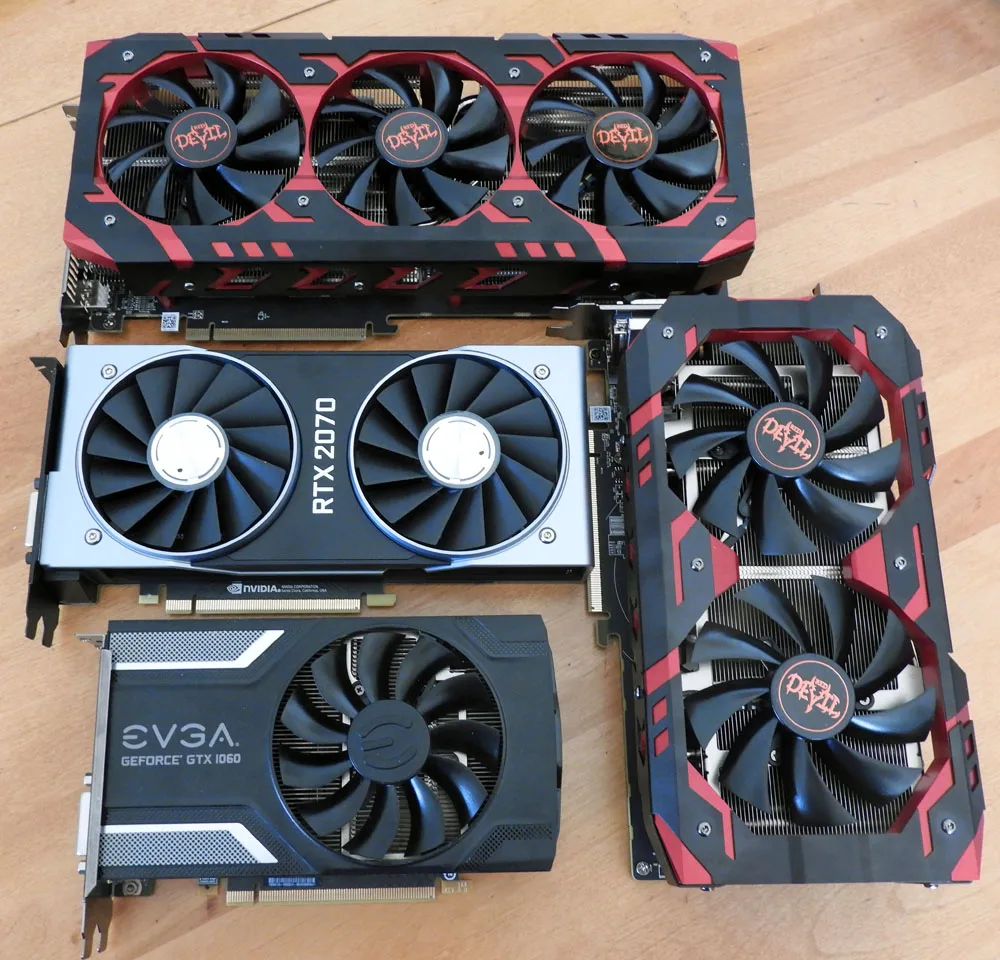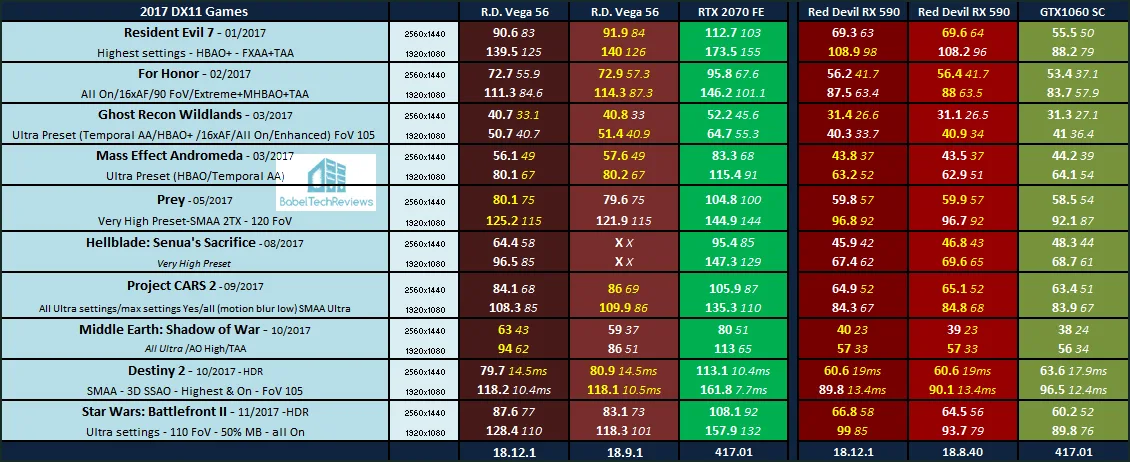Adrenalin Software Edition 18.12.1 Driver Performance Analysis featuring the Red Devils RX 590 and the RX Vega 56
As a returning feature for BabelTechReviews, this driver performance analysis will chart the performance of 37 PC games using the latest Radeon Software Adrenalin Edition 18.12.1 which was released last week. We will compare these drivers with the 18.8.40 launch drivers for the RX 590 and also with September’s drivers used for the RX Vega 56. For an additional comparison, we are also showing their main rivals, the RTX 2070 FE’s and the EVGA GTX 1060 SC’s performance on the latest GeForce 417.01 drivers.
Future BTR driver performance analysis will track the progress of every major driver release from NVIDIA and from AMD, and they will include every game in our recently updated 37-game benchmark suite including Hitman 2 and Battlefield V.
We will document the performance changes of the current Adrenalin Software 18.12.1 Edition on Windows 10 at 1920×1080 and at 2560×1440 resolutions. Our testing platform is a recent install of Windows 10 64-bit Home Edition, and we are using an i7-8700K which turbos all 6 cores to 4.7 GHz, an EVGA Z370 FTW motherboard, and 16GB of HyperX DDR4 3333MHz. The games tested, settings, and hardware are identical except for the drivers being compared.
Let’s get to the test configuration, to the driver release notes, and then to our results.
Test Configuration – Hardware
- Intel Core i7-8700K (HyperThreading and Turbo boost are on to 4.7 GHz for all cores; Coffee Lake DX11 CPU graphics).
- EVGA Z370 FTW motherboard (Intel Z370 chipset, latest BIOS, PCIe 3.0/3.1 specification, CrossFire/SLI 8x+8x), supplied by EVGA
- HyperX 16GB DDR4 (2×8 GB, dual channel at 3333 MHz), supplied by HyperX
- Red Devil RX 590 8 GB, at Red Devil RX 590 factory speeds, supplied by PowerColor.
- Red Devil RX Vega 56 8 GB, at Red Devil RX Vega 56 factory speeds, supplied by PowerColor.
- RTX 2070 Founders Edition 8GB, at FE speeds, supplied by NVIDIA
- EVGA GTX 1060 SC 6 GB, stock SC clocks, supplied by EVGA.
- 2 x 480 GB Team Group SSDs – one for AMD and one for NVIDIA
- 1.92 TB San Disk enterprise class SSD
- 2 TB Micron 1100 SSD
- Seasonic 850W Gold Focus power supply unit
- EVGA CLC 280mm CPU water cooler, supplied by EVGA
- Onboard Realtek Audio
- Genius SP-D150 speakers, supplied by Genius
- EVGA DG-77, mid-tower case supplied by EVGA
- Monoprice Crystal Pro 4K
Test Configuration – Software
- AMD’s Radeon Software Adrenalin Edition 18.12.1 is compared with 18.8.40 (press launch drivers) used for the RX 590 and 18.9.1 for the RX Vega 56.
- Nvidia GeForce 417.01 WHQL drivers are used for the GeForce cards.
- VSync is forced off.
- AA enabled as noted in games; all in-game settings are specified
- Gaming results show average frame rates in bold including minimum frame rates shown on the chart next to the averages in a smaller italics font.
- Highest quality sound (stereo) used in all games.
- Windows 10 64-bit Home edition. All DX11 titles were run under DX11 render paths. DX12 titles are generally run under the DX12 render path unless performance is lower than with DX11. Three games use the Vulkan API.
- Latest DirectX
- All 37 games are patched to their latest versions at time of publication
- Wattman for Radeons
- MSI Afterburner, latest beta for GeForce cards
- OCAT, latest version
- Fraps, latest version
37 PC Game benchmark suite & 4 synthetic tests
Synthetic
- Firestrike – Basic & Extreme
- Time Spy DX12
DX11 Games
- Grand Theft Auto V
- The Witcher 3
- Fallout 4
- Rainbow Six Siege
- Battlefield 1
- Resident Evil 7
- For Honor
- Ghost Recon Wildlands
- Mass Effect: Andromeda
- Prey
- Hellblade: Senua’s Sacrifice
- Project CARS 2
- Middle Earth: Shadow of War
- Destiny 2
- Star Wars: Battlefront II
- Kingdom Come: Deliverance
- Final Fantasy XV
- Far Cry 5
- The Crew 2
- Assassin’s Creed: Odyssey
- Call of Duty: Black Ops 4
- Hitman 2
DX12 Games
- Tom Clancy’s The Division
- Ashes of the Singularity: Escalation
- Hitman
- Rise of the Tomb Raider
- Deus Ex Mankind Divided
- Gears of War 4
- Civilization VI
- Sniper Elite 4
- Total War: Warhammer II
- Forza 7
- Shadow of the Tomb Raider
- Battlefield V
Vulkan Games
- DOOM
- Wolfenstein: The New Colossus
- Strange Brigade
AMD Control Center Radeon Settings
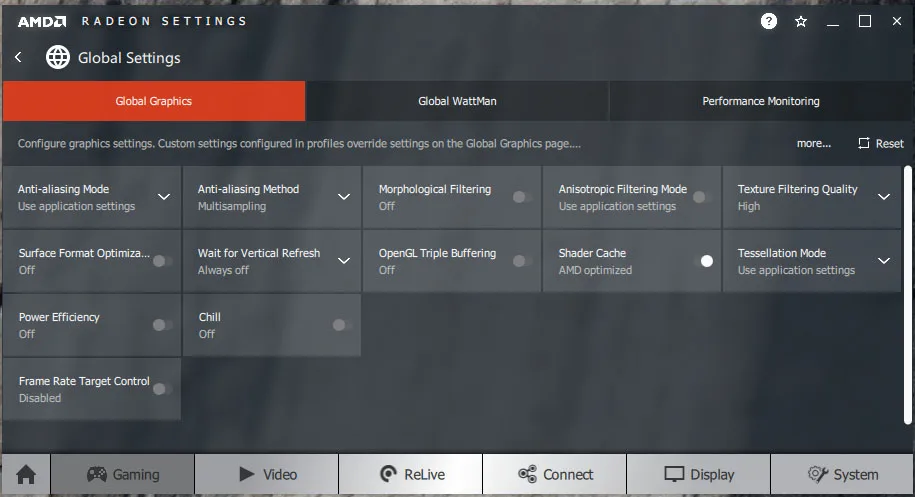 All AMD settings are set so as to be apples-to-apples when compared to NVIDIA’s control panel settings – all optimizations are off, Vsync is forced off, Texture filtering is set to High, and Tessellation uses application settings. We used Wattman to set power, temperature, and fan limits to their maximums to prevent throttling.
All AMD settings are set so as to be apples-to-apples when compared to NVIDIA’s control panel settings – all optimizations are off, Vsync is forced off, Texture filtering is set to High, and Tessellation uses application settings. We used Wattman to set power, temperature, and fan limits to their maximums to prevent throttling.
NVIDIA Control Panel settings
Here are the NVIDIA Control Panel settings.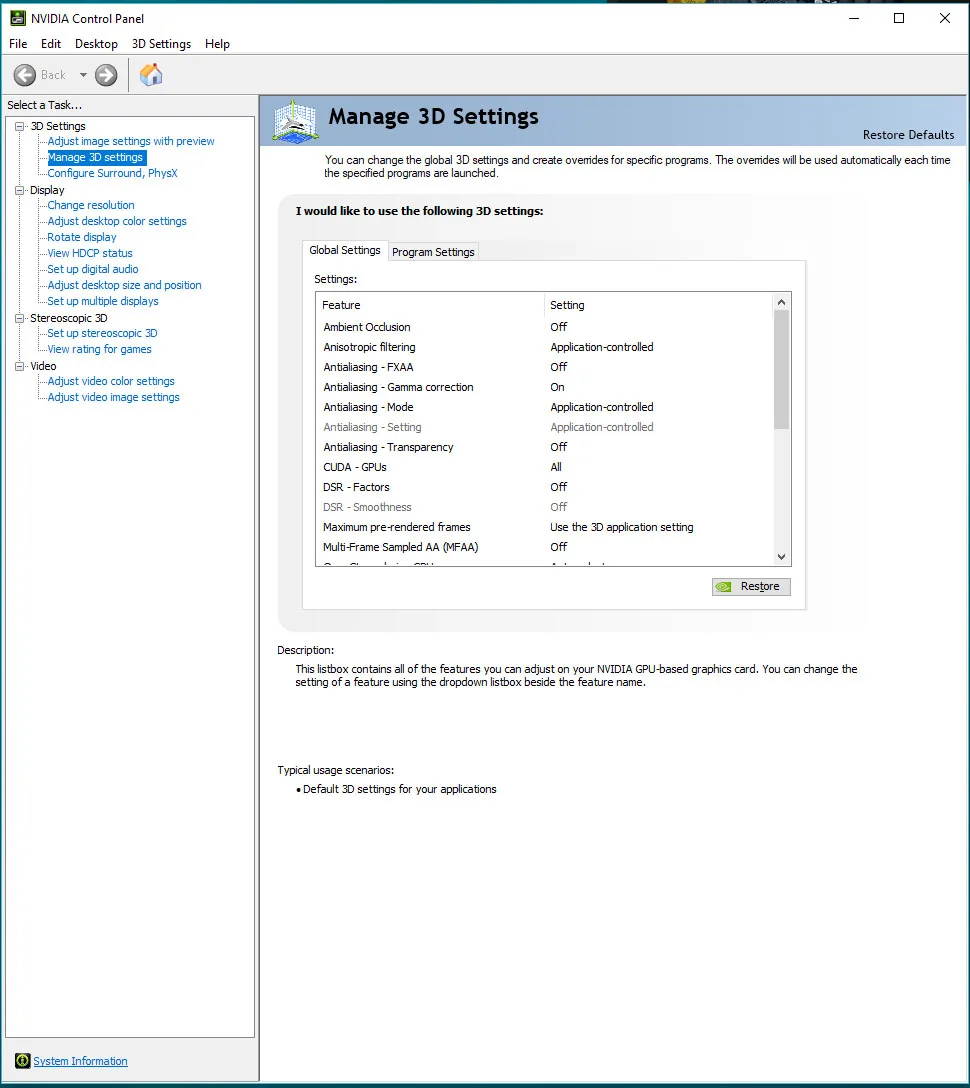
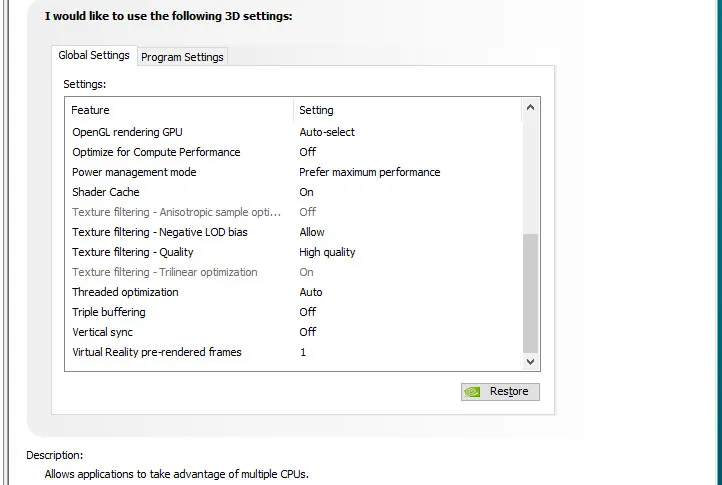 We used MSI’s Afterburner to set our GeForce’s highest Power and Temperature targets. By setting the Power Limits and Temperature limits to maximum for each card, they do not throttle, but they can each reach and maintain their individual maximum clocks stock or overclocked.
We used MSI’s Afterburner to set our GeForce’s highest Power and Temperature targets. By setting the Power Limits and Temperature limits to maximum for each card, they do not throttle, but they can each reach and maintain their individual maximum clocks stock or overclocked.
The release notes and download links for the latest Software Adrenalin 18.12.1 Edition can be found starting here. The release notes can also be found here. The included highlights below are from AMD’s website.
Radeon Software Adrenalin Edition 18.12.1 Highlights
Support For
- Just Cause™ 4
Known Issues
- Some systems running multiple displays may experience mouse lag when at least one display is enabled but powered off.
- Assassin’s Creed™: Odyssey may experience a game crash at certain locations of the game on Windows®7 enabled system configurations.
Package Contents
The Radeon Software Adrenalin Edition 18.12.1 installation package contains the following:
- Radeon Software Adrenalin Edition 18.12.1 Driver Version 18.40.11.09 (Windows Driver Store Version 25.20.14011.9004)
Let’s head to the charts to compare the driver changes from the older Adrenalin Software Editions to the brand new Adrenalin Software 18.12.1 Edition released last week.
The Summary Chart
Below are the summary charts of 37 games and 2 synthetic tests. The games’ performance are charted to compare the driver progression of the RX 590 from its press launch Adrenalin 18.8.40, and RX Vega 56 from 18.9.1 drivers to last week’s Radeon Software Adrenalin Edition 18.12.1. The highest settings are always chosen and the settings are listed on the charts. The benches were run at 1920×1080 and at 2560×1440. Open each chart in a separate window or tab for best viewing.
Most results show average framerates and higher is better. Minimum framerates are next to the averages in italics and in a slightly smaller font. A few games benched with OCAT show average framerates but the minimums are expressed by frametimes in ms where lower numbers are better.
The first two columns show the RX Vega 56’s performance. Columns one represents the latest 18.12.1 driver and Column two represents 18.9.1. For comparison, the RTX 2070 is included in the third column. The fourth column and fifth columns represent the RX 590’s performance – column four uses 18.12.1, and column five represents 18.8.40. The final sixth column compares the performance of the GTX 1060/6 SC. An “X” means the benchmark was not run or compared.
For RX Vega 56, we see mostly positive performance improvements and some of them are rather substantial with some of the newer games. There are a few regressions with the older games, however, and they appear to be relatively minor. On the other hand, there was very little performance improvement with the RX 590 on the latest drivers and they tend to be mostly incremental.
Unfortunately, we were hit with the same very serious Vulkan bug when installing the latest driver with the RX 590 that crashed all Vulkan games to desktop that has been reported with earlier drivers.
This Vulkan issue that we experienced still seems to be dependent on specific system configurations and it does not affect all cards. It has been acknowledged by the Vulkan developers, and it was not possible for us to fix it short of editing the Windows Registry or with a brand new Windows installation. Reinstalling the latest Radeon Software Adrenalin Edition 18.12.1 after running DDU in safe mode did not help nor did installing the Vulkan SDK, and we tried several other recommended fixes with no success. However, installing the RX Vega 56 right after the RX 590 eliminated the issue.
Let’s head to our conclusion.
Conclusion:
We would generally recommend upgrading to the latest Radeon Software Adrenalin Edition 18.12.1 from any previous driver set because there are generally advantages that are sometimes quite significant, depending on which game you are playing as we found with the RX Vega 56. Unfortunately the latest Vulkan bug affected our RX 590 and we cannot recommend updating to this driver if your older drivers are working well until it is resolved, especially if you play Vulkan games. 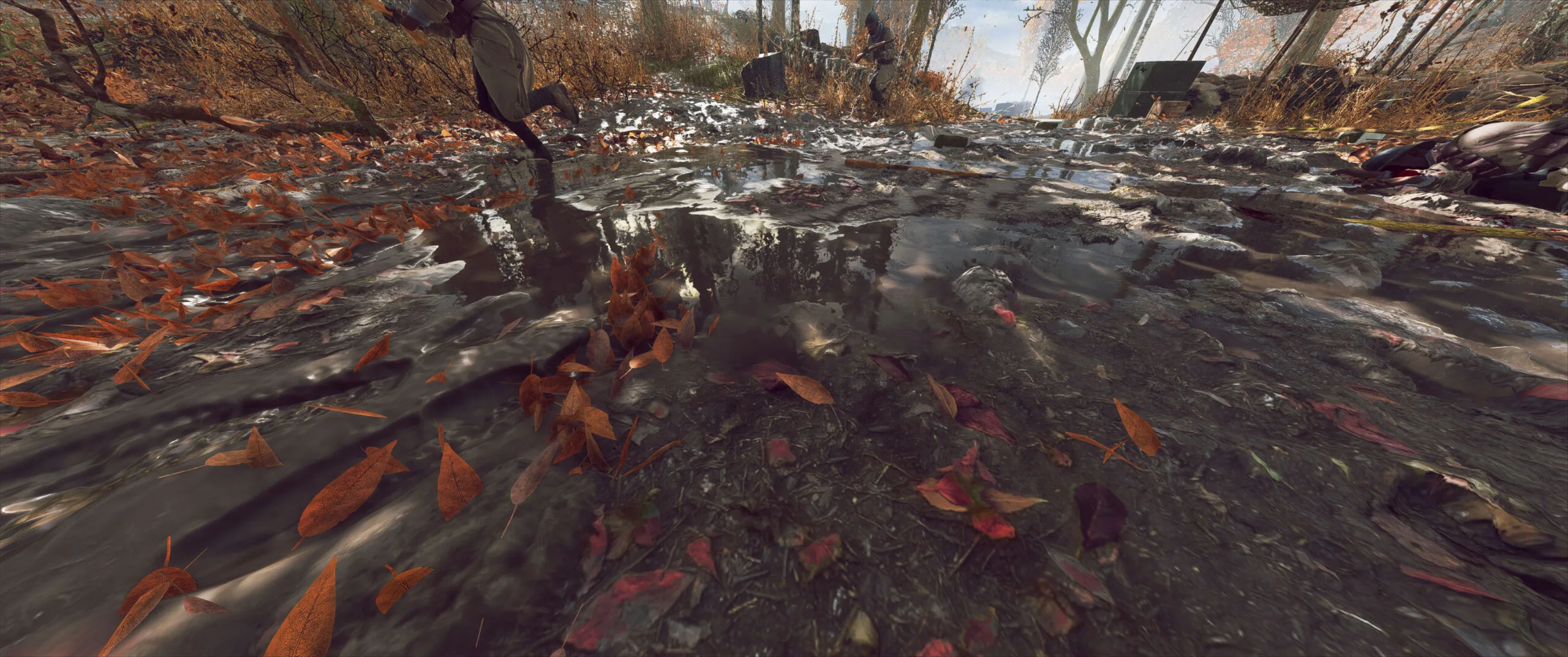
Tomorrow we will revisit RTX 2080 Ti/RTX 2080/RTX 2070 DXR performance in Battlefield V after the new patch drops. NVIDIA claims a 50% performance improvement with DXR framerates. And we have pre-loaded Just Cause 4 and it will become game number 38 in BTR’s benching suite.
Happy gaming!
